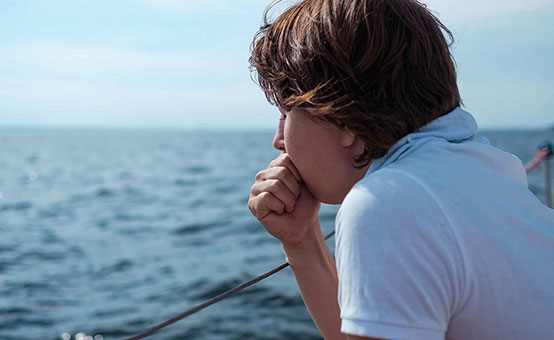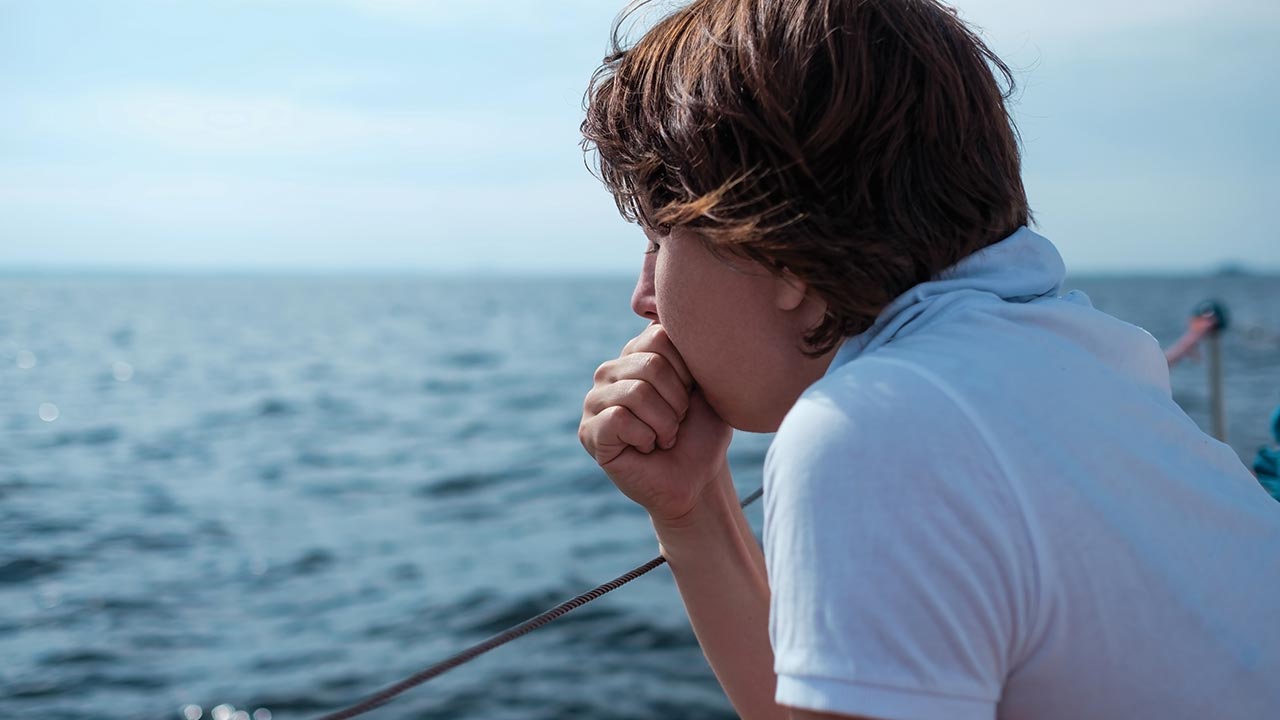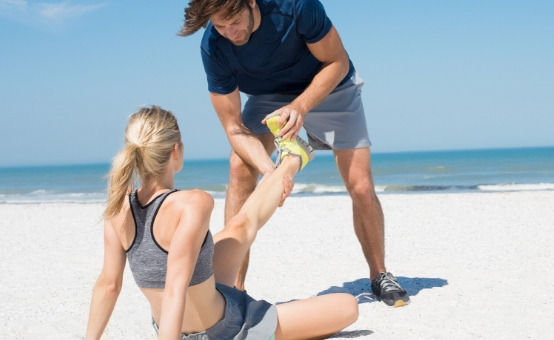

Hands up if you’ve experienced at least one bout of mal de mer in your lifetime. And don’t be embarrassed. Many people are prone to motion sickness; it’s waaaaay more common than you think. According to the Centers for Disease Control, nearly 100% of us have—or will—succumb to seasickness on rough waters.
Scientists have a fancy name for this malady—kinetosis—and it’s an age-old problem. Ancient Greeks referred to seasickness as the “plague of the sea,” and famous sufferers through the ages include Christopher Columbus, Admiral Horatio Lord Nelson and Charles Darwin.
Even the most seasoned mariners can fall prey to seasickness. Medical reports submitted by crews after the 2012 Newport to Bermuda race included 54 cases of seasickness. And according to a Yachting World survey of 450 sailors taking part in a 2015 ARC transatlantic rally, 26% experienced some degree of seasickness. Heck, producers of Deadliest Catch reveal that even Edgar Hansen of the Northwestern and Jonathan Hillstrand of Time Bandit still get seasick at the beginning of each season!
Think of it as a battle of the senses. Seasickness occurs when one part of your balance-sensing system (your inner ear, eyes and sensory nerves) senses that your body is moving, but the other parts do not. For example, if you’re in the cabin of a moving vessel, your inner ear may sense the motion of waves, but your eyes don’t detect any movement. This sensory mismatch confuses your brain, and in turn, you feel sick.
Symptoms of seasickness run the gamut from dry mouth, cold sweats, dizziness and drowsiness to mild headaches, nausea and vomiting. In other words, pure misery. But you don't have to suffer!
Learn more about seasickness in the full video here.
We’ve asked seasoned skippers, sailors, travel experts and medical professionals for their best tips and tricks for conquering seasickness and compiled this handy list of cures to help you get your sea legs.
Of course, what works for others may not work for you, so it’s good to be prepared with a few options. Also, keep in mind that these tips are not meant to be a substitute or replacement for any medical treatment. Always seek the advice of a healthcare professional regarding your specific health concerns.
#1 - Cast off well-rested...
One of the best ways to prevent seasickness is to take smart steps before even setting foot on a boat. “Get plenty of sleep before a voyage, since fatigue weakens your stamina,” advise Peter Flamisch and Vera Hovanyecz, who live aboard Irreversible and are hosts of Sail Over the Horizon on YouTube. Indeed, U.S. Navy research reveals that sleep deprivation magnifies the occurrence of seasickness by interfering with the vestibular system (located in small cavities hollowed out of bone within each ear) habituation process.
#2 - ...And well-nourished
You never want to tackle rolling seas on an empty stomach, but you don’t want to be stuffed, either. Nick Fabbri and Terysa Vanderloo, video bloggers of Sailing Yacht Ruby Rose, recommend having a stodgy, solid meal (such as oatmeal, bagels, pancakes, etc.) before boarding and making sure you ”graze” throughout the day and drink plenty of water. “We try to have sandwiches made up before leaving and easy-to-reach snacks (like apples, granola bars, and crisps), as well as full bottles of water in the cockpit.”
#3 - Arrive sober
Avoid alcohol 24 hours before boating. Even a mild hangover can easily turn into a nasty bout of seasickness.
#4 - Pop a pill
Dramamine and Bonine are the two most common and popular seasickness remedies. Both are essentially antihistamines and are available over-the-counter at most pharmacies. Both can also make you sleepy, so look for the non-drowsy formulas. Always take new medications on a test-drive—at least a week ahead of time—before using them on the water. If there are no issues, take the recommended dose the night before your trip, and then another dose at least an hour before leaving. This helps build up a defensive level of the drug in your body.
#5 - Patch things up
Scores of avid sailors spell seasick relief like this: SCOPOLAMINE patches. Sold under the brand name Transderm Scop, when placed on the skin (typically just behind the ear), this patch delivers the prescription drug scopolamine at a steady rate for up to three days. These patches work similarly to antihistamines by interfering with the communication between nerves and the part of the brain that controls vomiting. But patches last longer than antihistamines, and many insist they have fewer side effects. The patch is Wandering Educators’ Dr. Jessie Voigts’ go-to remedy. “I get seasick from any kind of movement, and it’s worse when I’m out on the water,” she reports. “Other seasickness remedies typically don’t work for me when there are big waves. But with the patch, you put it behind your ear four hours before and wait for it to kick in. It even stays on in water.”
It’s a good idea to wear a patch on dry land for at least 24 hours to test its effects and how you react to it. Wear only one patch at a time, never break one in half, and avoid alcohol when wearing a patch. Also, make sure to remove a patch after three days since withdrawal symptoms that mimic the very symptoms you’re trying to sidestep (dizziness, nausea, vomiting, headache and balance disturbances) can occur.
Important: When you open the foil wrapper, avoid touching the patch under the plastic strip. If some of the medication gets on your finger and inadvertently contaminates your eye, the drug will produce unilateral pupil dilation, which has caused confusion with several serious medical emergencies by those who are unaware of this association.
#6 - Go natural
Hands down, ginger is the most common herbal remedy for seasickness and has been used by sailors for centuries. Researchers at Brigham Young University and Mount Union College in Ohio found that taking a gram of ginger trumped the recommended dosage of dimenhydrinate (Dramamine) for motion sickness. Researchers believe that ginger works via the digestive track vs. shutting down messages to the brain, which is how most prescription and over-the-counter anti-nausea drugs work. Out Chasing Stars video blogger Amy Alton prefers raw ginger to capsules. “If I have crystallized ginger, that’s great,” she says, “but ginger beer also works.” Nick Fabbri from Sailing Yacht Ruby Rose, on the other hand, prefers ginger tea and ginger lollipops. Other natural remedies sailors swear by include peppermint and lemon drops.
Note: Ginger can thin the blood, so consult your doctor first if you’re on high blood-pressure medication.
#7 - Band it
One popular drug-free option for preventing seasickness is a wristband. While based on the ancient practices of Chinese acupuncture, the concept of a sea band wasn’t invented until 1980 when physician and surgeon Dr. Daniel Choy was participating in the Newport to Bermuda race, and his seasick pills got wet and melted in his pocket. By applying pressure to a point located on the underside of his arm—about an inch and a half above the wrist—Dr. Choy found relief.
Nowadays, there are a variety of hands-free options in the form of anti-seasickness wrist bands that exert gentle pressure on that “sweet spot”, thus suppressing nausea. You can find these at marine and travel stores, as well as online. There are also more sophisticated, battery-operated versions—like the Relief Band—that deliver a mild electrical pulse instead of pressure.
The scientific jury is still out on whether sea bands are effective, but many sailors—like Penny Sadler from Adventures of a Carry-On, rarely sail without wearing one. “I was working on a two-week cruise from Miami to Los Angeles via the Panama Canal and decided to take a pre-emptive approach,” she says. “Preferring to avoid medication whenever possible, I wore a wrist band that stimulates acupressure points, and it worked like a charm for me.”
#8 - Inhale
Captain Gino, a licensed captain with 25 years of sailing under his belt, recommends Quease Ease to his crew and passengers. This all-natural inhaled seasickness reliever was formulated and developed by a U.S. Certified Registered Nurse anesthetist to calm surgery- and anesthesia-related queasiness. The concoction is made from peppermint, lavender, ginger, and spearmint essential oils. “You remove the cap, take a few breaths when needed, then put the cap back on,” says Captain Gino. “Done. Magic.”
#9 - Steer the ship
“The thing that works best for me if I feel seasick is taking the helm,” says Kelly Porter, who hosts YouTube’s Sailing Satori with Nick Johnson. “There’s something about ‘driving’ the boat and the breeze in your face that cures it.” Indeed, sitting in the front seat and keeping your eyes on the horizon can work wonders by giving you a feeling of control over the elements. Remember, motion sickness is caused in part by conflicting signals to your brain. But by looking up and out, your peripheral vision will see the ocean swells that you feel. The whole picture will make more sense to your brain, and you will regain your sense of equilibrium.
#10 - Stick to the middle ground
When symptoms of seasickness sneak up on you, it’s easy to want to go below and curl up in a ball, or helplessly hug the head—but resist that urge. According to Captain Michael Simon, an Intrepid Travel skipper with over a decade of experience sailing ships around the Caribbean, “The more fresh air you expose yourself to, the less likely you are to feel the effects of seasickness.” By the same token, try to brace yourself at the center of the boat where rocking and rolling is less amplified, and avoid areas with strong fumes, particularly fuel or exhaust.
#11 - Watch what you eat
Stuff your face with spicy, greasy, high-fat foods, and when the waves hit, you’ll pay the price. Keep your diet bland for the most part, but also keep your stomach full by noshing on healthy snacks—like green apples and citrus candy, which ship crew members and seasoned scuba divers alike insist help quell nausea. Or try this trick from seasick sufferer Kim Brown, author of Checklists for Sailors: Passage Planning, Sailboat Maintenance, Cleaning, Medical and More: “Living aboard Britican, I often chew quite a bit of gum. For some reason, it settles my stomach,” she says. “Hard candies also work well.”
#12 - Guzzle water
It’s a no-brainer that it’s important to stay hydrated—always. But this is particularly important at sea. Dehydration can not only limit the body’s ability to handle destabilizing motion, but it can also bring on symptoms of seasickness—or make them worse if you’re already feeling lousy. In addition to water, Gatorade is another great choice to keep those electrolytes pumping into your body. Alcohol, however, is a no-no, as it’s dehydrating.
#13 - Avoid face time
Reading—whether it’s on your phone, iPad, computer or paper—is an open invitation to get seasick. That’s because focusing your eyes on an apparently stationary target convinces your brain even more that your middle ears are wrong. So, until you get your sea legs, keep these devices stowed away.
#14 - Think high C’s
In one study of people who took either two grams of vitamin C or a placebo and then spent 20 minutes on a life raft in a wave pool, those who took the supplement had reduced levels of seasickness. This trick likely works because the brain makes histamine, which makes you seasick, and vitamin C cuts its production.
This is a remedy expert sailors John and Amanda Neal of Mahina Expeditions rely on before every passage, only the Neals prefer to guzzle Emergen-C. “That way we get the vitamin C in a drink, which gets both water and vitamins into the body—and neither has side effects,” they explain.
#15 - Plug it
Insert an earplug into one ear. This is a trick video blogger Christopher Barr of Sailing Britaly says worked wonders for him while battling 10-meter waves in the North Sea. How does it work? “Seasickness is caused by conflicting signals being sent to your brain from your eyes and your inner ears—your cochlea,” he theorizes. “The movement that you’re being subjected to is being detected by your cochlea. The two cochleae send messages to your brain telling it that you are moving. If you’re on a boat, your eyes will see the environment moving with you, and your eyes send messages to your brain telling it that you are not moving. This mismatch between the cochlea and the eyes is what makes you feel sick. By plugging one ear, however, your brain senses that there’s something wrong with your ears, and so it ignores the signals that are being sent by your cochlea. It then concentrates on the signals being sent from your eyes—and of course, if you look around, you’ll see movement—and it’s these signals that the brain concentrates on. It’s a very simple trick, but it can actually stop you from getting seasick.”
Other sailors who use this trick claim it works best when you insert the earplug into the opposite ear from your dominant hand (if you’re right-handed, place the earplug in your left ear).
#16 - Sleep it off
When nothing else works, try snoozing. Sail Over the Horizon’s Veronika Hovanyecz says, “When I feel really bad, I lie on my back in the most stable berth on the boat until I fall asleep.” Even if you have trouble sleeping, at the very least, lying down prevents histamine from reaching the brain, thus decreasing nausea. Plus, by closing your eyes, your brain will be on the receiving end of fewer of the mixed signals that can lead to seasickness.
#17 - Ride it out
Take heart! According to the Yachting World survey, seasickness typically lasts just one or two days tops. And the majority (60%) of sufferers said it didn’t keep them from taking part in any activities on board. On another high note, the survey also suggested that incidences of seasickness may decrease as you get older, typically peaking between the ages of 20 and 29.
Here's some even better news: Seventy-five percent of people eventually get acclimated to the sea and are naturally cured. And if you’re in that other 25%? Well, now you know what to do!
MORE FROM
SAFE PASSAGE

TRAVEL HEALTH | Apr 6, 2020
Symptoms at Sea: How to Treat and Prevent Muscle Cramps
![[video] family boaters man overboard drills](https://danboater.org/travel-health-and-safety/images/man-overboard-procedure-man-overboard-now-what-dan-boater-m.jpg)
BOATING SAFETY | May 2, 2020
Man Overboard! (Now what?!)
THIS WEBSITE DOES NOT PROVIDE MEDICAL OR DENTAL ADVICE.
It is intended for general informational purposes only and does not address individual circumstances. It is not a substitute for professional medical or dental advice, diagnosis or treatment and should not be relied on to make decisions about your health. Never ignore professional medical or dental advice in seeking treatment because of something you have read on the DAN Boater website. If you think you may have a medical emergency, immediately call your doctor, dial 911, or contact emergency services nearest you.